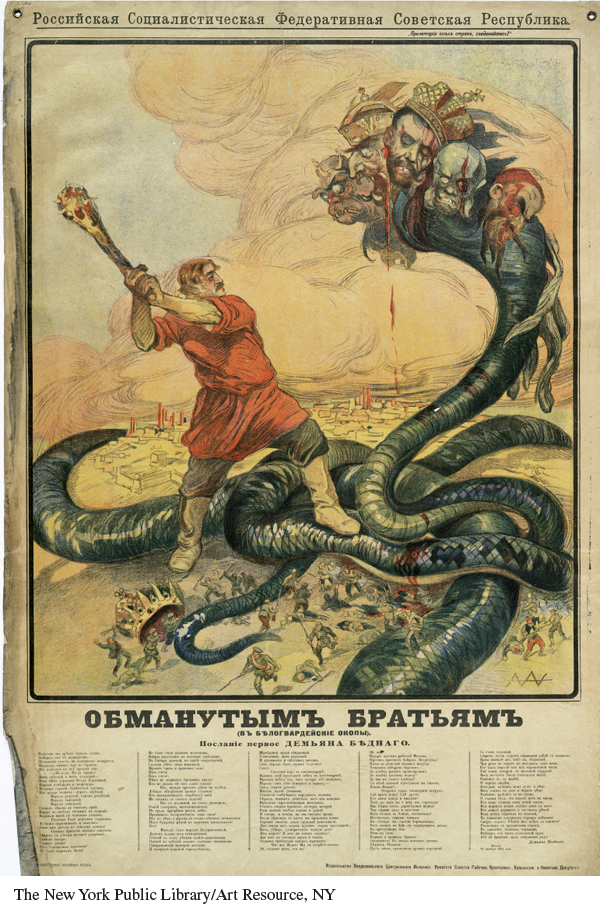A History of Western Society: Printed Page 849
A History of Western Society, Value Edition: Printed Page 817
A History of Western Society, Concise Edition: Printed Page 850
Dictatorship and Civil War
The Bolsheviks’ truly monumental accomplishment was not taking power, but keeping it. Over the next four years, they conquered the chaos they had helped create and began to build a Communist society. How was this done?
Lenin had the genius to profit from developments over which the Bolsheviks had little control. Since summer, a peasant revolt had swept across Russia, as impoverished peasants had seized for themselves the estates of the landlords and the church. Thus when Lenin mandated land reform, he merely approved what peasants were already doing. Similarly, urban workers had established their own local soviets or committees and demanded direct control of individual factories. This, too, Lenin ratified with a decree in November 1917.

The Bolsheviks proclaimed their regime a “provisional workers’ and peasants’ government,” promising that a freely elected Constituent Assembly would draw up a new constitution. But free elections in November produced a stunning setback: the Bolsheviks won only 23 percent of the elected delegates. The Socialist Revolutionary Party — the peasants’ party — had a clear plurality with about 40 percent of the vote. After the Constituent Assembly met for one day, however, Bolshevik soldiers acting under Lenin’s orders disbanded it. By January 1918 Lenin had moved to establish a one-
Lenin acknowledged that Russia had effectively lost the war with Germany and that the only realistic goal was peace at any price. That price was very high. Germany demanded that the Soviet government give up all its western territories, areas inhabited primarily by Poles, Finns, Lithuanians, and other non-
At first, Lenin’s fellow Bolsheviks refused to accept such great territorial losses. But when German armies resumed their unopposed march into Russia in February 1918, Lenin had his way in a very close vote. A third of old Russia’s population was sliced away by the Treaty of Brest-
The peace treaty and the abolition of the Constituent Assembly inspired armed opposition to the Bolshevik regime. People who had supported self-
By the summer of 1918 Russia was in a full-
Lenin and the Red Army beat back the counter-
Ironically, foreign military intervention helped the Bolsheviks. For a variety of reasons, but primarily to stop the spread of communism, the Western Allies (including the United States, Britain, France, and Japan) sent troops to support the White armies. Yet their efforts were limited and halfhearted. By 1919, with the Great War over, Westerners were sick of war, and few politicians wanted to get involved in a new military crusade. Allied intervention failed to offer effective aid, though it did permit the Bolsheviks to appeal to the patriotic nationalism of ethnic Russians, in particular former tsarist army officers who objected to foreign involvement in Russian affairs.
Other conditions favored a Bolshevik victory as well. Strategically, the Reds controlled central Russia and the crucial cities of Moscow and Petrograd. The Whites attacked from the fringes and lacked coordination. Moreover, the poorly defined political program of the Whites was a mishmash of liberal republicanism and monarchism incapable of uniting the Bolsheviks’ enemies. And while the Bolsheviks promised ethnic minorities in Russian-
The Bolsheviks mobilized the home front for the war by establishing a system of centralized controls called War Communism. The leadership nationalized banks and industries and outlawed private enterprise. Bolshevik commissars introduced rationing, seized grain from peasants to feed the cities, and maintained strict workplace discipline. Although normal economic activity broke down, these measures maintained labor discipline and kept the Red Army supplied with men and material.
Revolutionary terror also contributed to the Communist victory. Lenin and the Bolsheviks set up a fearsome secret police known as the Cheka, dedicated to suppressing counter-

By the spring of 1920 the White armies were almost completely defeated, and the Bolsheviks had retaken much of the territory ceded to Germany under the Treaty of Brest-